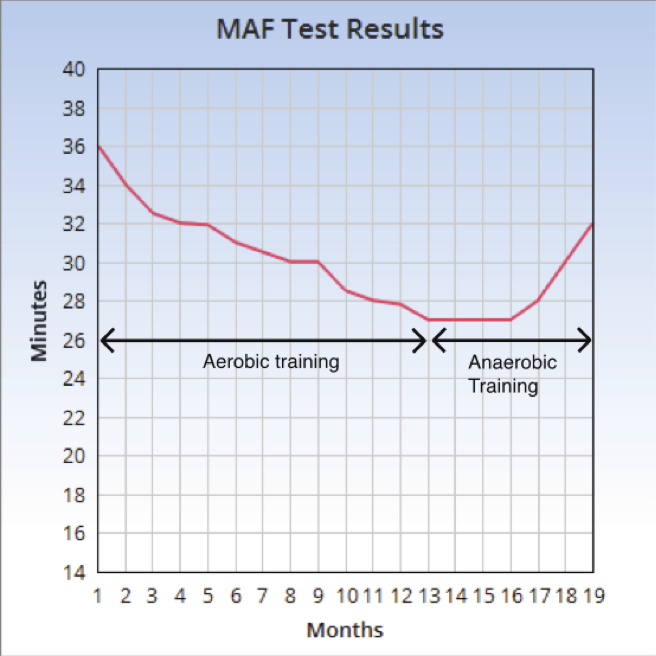
By comparing heart rate, speed, time and distance during workouts, the MAF-GPS Test, a sub-maximal evaluation, can help measure fitness progress and health status, and even raise a red flag for problems.
Maximum aerobic function reflects various physical and metabolic features important for participants in all sports. All athletes benefit from improved aerobic muscle fiber activity to support anaerobic muscles for optimal power, strength and recovery. Endurance athletes in particular rely on the aerobic system for increased fat-burning to provide long-term energy and conservation of glycogen.
Maximum aerobic function, or MAF, should be objectively evaluated year-round to avoid loss of training progress, and also to give clues about various wellness factors that reflect both fitness and health.
Years ago, I developed the MAF Test to help individuals monitor the progress of their aerobic training programs. Whether you are an elite triathlete, mid-pack marathoner, someone seeking to lose body fat or weight, or you’ve just made the commitment to get back into shape, this simple test can help measure aerobic progress, and warn of a training plateau or regression.
For years the traditional test relied on pre-measured routes, such as a track, to evaluate MAF. However, ready availability of global positioning system (GPS) devices has provided another simple method to test for MAF. With GPS, one need not rely on a local running track, but the test can be done various ways as discussed below, and anywhere void of steep hills (which make it more difficult to maintain the appropriate heart rate).
Our new MAF iPhone App has a MAF Test function that you can use to take your MAF tests systematically and observe the development of your aerobic system across time. At the bottom of the article we provide a link that takes you directly to the MAF App in the app store.
Monitoring Fitness
The body’s aerobic system is based in fatigue-resistant muscle fibers fueled by fat. It has long been recognized that the vast majority of endurance-based sports, such as running, cycling, triathlon and cross-country skiing, require most energies be derived from aerobic metabolism. For example, 99 percent of the energy needs for a world-record marathon comes from the aerobic system. For an Ironman triathlon it’s more than that, and in relatively shorter races such as a 10k run, it’s still 95 percent. Even during a one-mile event, 65 percent of energy needs are aerobic-dependent.
Athletes who run track and field, or who play soccer, basketball and other team sports, and even those performing high-level power events such as weight-lifting and wrestling, can benefit from improved aerobic function. Well developed aerobic fibers can help neighboring anaerobic fibers function better and recover faster by improving circulation of oxygen and other nutrients while disposing of unwanted byproducts within the power muscles.
Monitoring Health
The MAF-GPS Test can also help monitor health, especially in avoiding overtraining. For example, as one can run faster at the same heart rate, burning more body fat for energy follows, which leads to many health benefits and fat loss. Both versions of the test reflect efficacy of physical movement. Better running economy, for example, is associated with faster paces at the same heart rate. This is most likely associated with the body’s ability to self-correct muscle imbalance more quickly, in addition to having more energy from fat. As such, aerobic progress is usually accompanied by reduced rates of injury, and a lower risk of overtraining.
The traditional MAF Test measures two workout elements — such as time and distance — while maintaining a constant sub-max heart rate. A review of the original test can help better understand the GPS version.
The Traditional MAF Test
I developed the original MAF Test around 1980. In common use today, it consists of measuring an athlete’s workout while maintaining a sub-max heart rate. (The sub-max heart rate corresponds with low- to moderate-intensity training. See the MAF 180 Formula on how one can determine maximum aerobic heart rate for training and testing.)
An example of a runner performing the test follows:
- An easy 12- to 15-minute walking or jogging warm-up.
- A run consisting of a predetermined distance, such as three, four or five miles, at sub-max HR, with each single mile time recorded. Beginners or walkers can use a one-mile (1.6 km) test.
- A 12- to 15-minute easy active cool down (if this is the end of the workout).
It’s best to perform each test on the same track, time of day, and wearing the same shoes. The test should not be performed during inclement weather (including unusually high or low temperatures, rain, snow, or excess wind), or during illness.
Below are the results of a runner’s four monthly outdoor track MAF Tests consisting of three miles each.
Test 1
Mile 1 8:44
Mins/mileMile 1: 8:44Mile 2: 8:52
Mile 3: 9:10
Test 2
Mile 1 8:36
Mins/mileMile 1: 8:36Mile 2: 8:48
Mile 3: 8:57
Test 3
Mile 1 7:58
Mins/mileMile 1: 7:58Mile 2: 8:02
Mile 3: 8:10
These results are the expected norm in a healthy athlete. Some individuals progress at slower rates, while others faster. Within a single test, progressive mile times are usually slower, due to mild fatigue. With aerobic progress, three results should become evident:
- A faster pace of test miles each month.
- The gap between the first and last mile becoming more narrow reflecting reduced fatigue, increased fat-burning, better economy or other factors.
- For competitors, there is a direct relationship between aerobic progress and anaerobic performance. Improved MAF Tests lead to quicker race times. Using resulted determined from traditional MAF Tests on a track, for example, if a runner’s first mile MAF Test is 8 minutes the expected per-mile pace for a flat 10k is around a 6:30. In a marathon, the expected race pace on a typical course would be about 7:45. (Other sports have not been measured with this level of precision.)
The most common question about the MAF Test is, “What happens if I don’t improve?”
Red Flag: Caution!
If the above results are not forthcoming, it should be a red flag. The most common reason for this is a lack of aerobic improvement with potentially, any number of problems being the cause. Likewise, a test with worsening results, such as slower times, may be a more serious problem as training is regressing.
The reasons for the lack of progress could be many, but a common cause is too much high-intensity training as described in a case history below.
The chart below reflects MAF Test results of a runner during a 19-month training period using the same relatively flat 5k course. Training during month one through 12 was exclusively at the sub-max MAF heart rate, followed by a period of seven months that included substantial anaerobic intervals and weight-lifting. The runner’s progress plateaued quickly at the onset of anaerobic training, and began deteriorating after three consecutive months of high-intensity training. In this particular athlete, this regression reflected the earliest stages of an overtraining syndrome. (By returning to aerobic-only training, not shown on the chart, this runner was able to ultimately improve MAF Test times again.)
MAF Test Chart
Various versions of the MAF Test are used for other sports such as cycling, rowing, walking, cross-country skiing, motor sports and canoeing, with athletes in basketball, soccer, football and other team sports performing the test while running or on a stationary bike. Different performance measures are often employed that include the relationship between sub-max heart rate and two other factors of time, distance, pace/speed or power (watts). The use of GPS has made the MAF Test much easier.
GPS
The implementation of the MAF-GPS Test is similar to the traditional test, follows the same logic but can be performed almost anywhere. One can employ it during regular training runs, rides, hikes and other workouts, even rowing or paddling on a waterway. The GPS will provide information about distance and time. But it’s important to use the same course each time so an objective comparison can be made. Activities should also be evaluated for at least 15 to 30 minutes.
Here’s an example of a cyclist riding three loops of a road course. The first loop took 28 minutes, the second 32 and a third 37 minutes. A month later, loop times are 26, 29 and 33 minutes. You should now be able to apply this same concept to your particular workout and sport.
Another GPS measure to consider is distance covered over the same time frame. If you normally work out for an hour, for example, building the aerobic system should result in a faster pace leading one to run, ride or otherwise cover more distance during that one-hour period.
Whatever method of measurement used for your MAF-GPS Test, stick with it so you compare the same test format.
5 Ways to Test
Below are five specific ways to test aerobic development using GPS. (Except for No. 3, all can also be performed with just a heart-rate monitor and watch.)
- Minutes per mile or kilometer. Following the traditional MAF Test format, one measures minutes per mile or kilometer. One should become faster per mile or km.
- Course time. Measure total time of your test course, regardless of the distance (which you’ll know from GPS data). Course time should get faster.
- Distance per workout. Determine the distance traveled during your regular workout. A one-hour workout, for example, should have more distance covered.
- Power meter (watts). How much power output is measured over the test course, or during the workout period.
- Pool laps. The number of laps in a pool in a set time. A swimmer can perform more laps in the allotted timeframe.
For those with a long history of traditional MAF Testing, you can still use GPS on the track, especially for the ease of recording the data into your iPhone.
But one need not wait a month to monitor progress. An MAF-GPS Test can literally be performed during each workout. However, daily monitoring runs the risk of an obsession similar to stepping the scale each morning. Our normal circadian variations in human physiology may fluctuate from one day to the next and not be measurable. Sometimes, the day to day variation may even appear negative as certain days the body just does not want to go as fast. But as the weeks pass, overall changes are more consistent and easily observed.
The MAF-GPS Test, like the traditional version, can help take the guesswork out of training by objectively measuring progress, and even prevent lost training time, injury and overtraining.
GPS as Radar
For decades, athletes have checked their morning heart rates, with an elevated number being a forewarning of a problem, such as an oncoming cold or flu, or other stress, even a potential injury. More recently, we have learned that heart-rate variability can provide radar-like warning of potential overtraining or poor recovery.
Both MAF Tests work in very similar ways, but with a more fined-tuned measure and more precise numbers, especially for those who have a good track record of testing.
In addition to an early onset of overtraining, as highlighted in the example above, other factors can prevent aerobic progress. These include poor mechanical (such as an altered gait), metabolic stress (reduced fat-burning) or hormone imbalance (such as an increase in the stress hormone cortisol). The result is you run, ride, or otherwise workout slower at the same heart rate as the days and weeks pass.
Along with excess anaerobic/high-intensity training, weight-lifting, and or racing, as shown in the example above, two other common problems that could impair aerobic progress include:
- The intake of refined carbohydrates, which can impair fat burning and reduce the extra energy needed to go faster (especially when these foods or drink are consumed right before the Test, or workout).
- Inadequate recovery, typically from previous workouts or recent weeks of accumulated training and or racing, or poor sleep.









